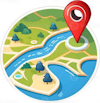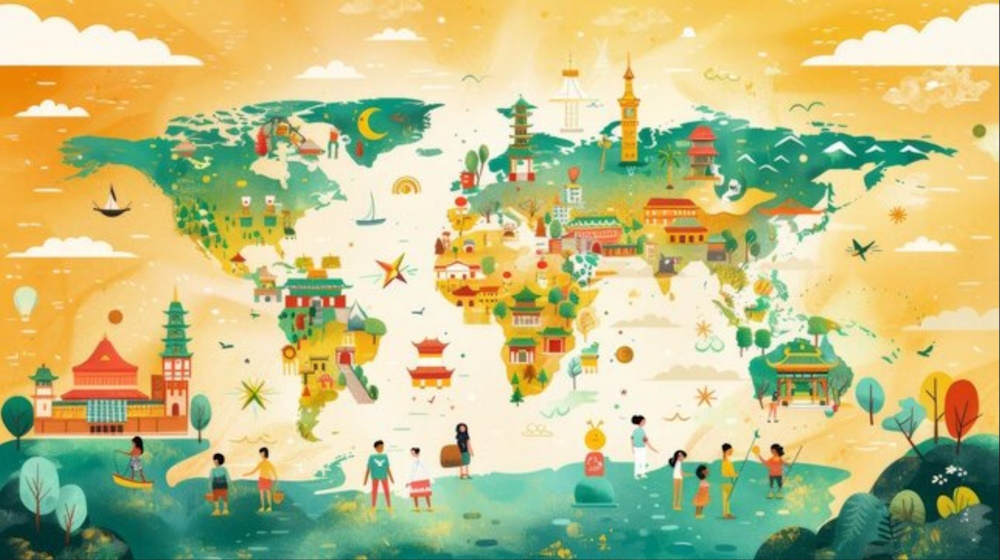 AI
Map Generators
AI
Map Generators
Advanced tools that use AI to create maps from text commands
More AI generation tools: Audio | Code | Images | Music | Text | Video
AI-generated maps have become increasingly popular for various applications, from gaming and fiction to urban planning and navigation. They have also become increasingly sophisticated, offering new possibilities for rapid map creation and updates. AI in map generation not only saves time, but also opens up possibilities for creativity and accuracy in mapping that were previously unattainable manually. However, the quality and usefulness of AI-generated maps depend heavily on the quality of input data and the sophistication of the AI algorithms. As the technology continues to evolve, AI-generated maps are expected to become more detailed, accurate, and easily updatable, revolutionizing the field of cartography, geographic information systems, and for enthusiasts who love making maps.

 Popular Products
Popular Products
MapsGPT
This tool uses AI to build custom maps by combining OpenAI's technology with Proxi's mapping capabilities. It enables users to generate maps based on specific criteria or interests, like finding historical sites or planning a trip.
Textomap
Converts text into interactive maps quickly, which is useful for educational purposes or when you need to visualize data geographically without the hassle of manual mapping.
AI Map Generator by Perchance
Focused on creating fantasy maps, this tool leverages Stable Diffusion to generate high-quality, artistic maps from text descriptions, perfect for role-playing games or fiction writing.
Rapid
Utilizes AI alongside OpenStreetMap data to predict and map features from satellite imagery, making mapping more efficient and accurate, especially in humanitarian contexts like disaster response.
MyMap AI
An AI tool that helps in creating mind maps but can also be used for generating conceptual or visual maps from text or uploaded documents, useful for brainstorming or educational purposes.
OpenMapFlow Library
An open-source Python library from Github for rapid map creation using machine learning and remote sensing data. It offers a data processing pipeline for creating labeled datasets, code to train deep learning models on custom or existing datasets, and a cloud-based architecture for efficient map prediction.
 How They Work
How They Work
AI algorithms can interpret vast amounts of geographic data, including satellite imagery, elevation data, and existing map data to generate new maps. They can recognize patterns in terrain, vegetation, and urban layouts to predict and draw map features. AI can update maps in real-time by processing live data from various sources, which is particularly useful for dynamic environments like traffic maps or disaster areas where quick updates are necessary. Users can specify preferences for map style, elements to highlight (like roads, rivers, or points of interest), and even thematic elements for fictional maps, allowing for highly personalized outputs. For fantasy or game scenarios, AI can use procedural generation techniques to create unique, detailed landscapes. This involves setting parameters like terrain types, climate zones, or population distribution to generate diverse and coherent maps.
 Applications
Applications
Google Maps
The best known example of AI maps is undoubtedly Google Maps, which uses AI extensively to provide accurate navigation, traffic predictions, and personalized recommendations. It deserves special mention here because of its extensive use of AI, but it does not generate maps like the products listed above.
- Navigation and Route Planning: AI algorithms calculate the best possible route based on factors like distance, traffic conditions, and road closures.
- Machine Learning: Learns patterns from historical data to predict traffic and optimize routes dynamically.
- Crowdsourced Data: When location sharing is enabled, AI processes data from users' mobile devices to detect traffic congestion.
- Predictive Models: Uses historical traffic trends combined with real-time data to predict future conditions.
- Partnerships: Collaborates with local authorities and businesses to factor in roadwork or special events.
- Crowd Contributions: Reviews, photos, and edits submitted by users are processed and verified by AI.
- Personalized Recommendations: AI analyzes your behavior, preferences, and location history to suggest places like restaurants, cafes, or tourist spots.
- Natural Language Processing: Powers search queries to interpret complex requests like "Best pizza near me."
- Predictive ETAs: Neural networks analyze traffic speed, road conditions, and weather to estimate your arrival time.
- Historical Data: Helps refine predictions based on the time of day or past trends for similar routes.
- Indoor Mapping and Navigation: Augmented reality features like Live View use AI to guide users inside malls, airports, or transit stations.
- Computer Vision: Recognizes visual cues like store signs and matches them to the map. Tools like Google's Street View and AI image recognition help map landmarks and update business information.
- Sustainability Initiatives: Google Maps uses AI to suggest eco-friendly routes with lower fuel consumption, based on factors like terrain and traffic patterns.
- Carbon Emission Tracking: Calculates the environmental impact of trips.
- Autonomous Vehicles: Google's self-driving car project, Waymo, integrates Google Maps data with advanced AI to navigate autonomously.
AI-Powered Global Mapping
Impact Observatory, in partnership with NGA, Esri, and Microsoft, has made strides in AI-generated maps:
- Launched the first publicly available 10-meter resolution land-cover map using machine learning.
- Developed a prototype for near real-time global mapping and change monitoring.
- Maps are updated whenever new imagery is available, aiming for continuous, automated updates at a global scale.
- Capabilities include showing seasonal changes, impacts of events like the war in Ukraine, and distinguishing between crops, trees, rangeland, built areas, water, and more.
More areas where AI generated maps are useful:
- Gaming: AI-generated maps are widely used in video games for creating unique levels or worlds each time a game is played.
- Urban Planning: AI can assist in visualizing potential urban developments or analyzing current city layouts for better infrastructure planning.
- Education and Research: For teaching geography, history, or even for research where geographical visualization is key.
- Navigation: AI can enhance navigation apps by providing real-time updates or suggesting optimal routes based on current data.
- OpenMapFlow: Tasks like cropland, crop type, and building mapping, reducing the time required for dense prediction compared to traditional workflows.
 Limitations
Limitations
While AI map generation is advancing, it still has some limitations:
- Current AI models may struggle with complex map features like isometric views or detailed borders.
- For specific mapping needs, specialized tools like Azgaar's Fantasy Map Generator may be more suitable.
- AI-generated maps may require refinement or human oversight for accuracy.
 Links
Links
proxi.co/blog/guide-to-mapsgpt
theresanaiforthat.com/ai/maps-gpt/ and mapwith-ai/
ojs.aaai.org/index.php/AAAI/article/view/
nga.mil/news/AI_Revolutionizes_Mapping_Updates_and_Accuracy.html
altexsoft.com/blog/ai-image-generation/
reddit.com/r/rpg/comments/14m6wse/anyone_been_successful_at_generating_maps_with/